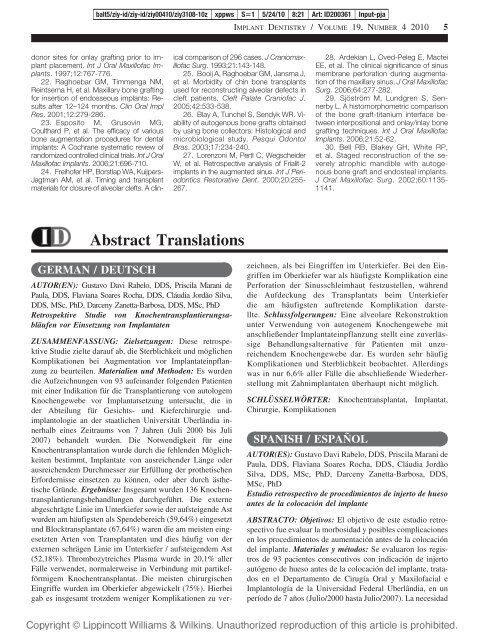Retrospective Study of Bone Grafting Procedures Before Implant ...
Retrospective Study of Bone Grafting Procedures Before Implant ...
Retrospective Study of Bone Grafting Procedures Before Implant ...
You also want an ePaper? Increase the reach of your titles
YUMPU automatically turns print PDFs into web optimized ePapers that Google loves.
alt5/ziy-id/ziy-id/ziy00410/ziy3108-10z xppws S1 5/24/10 8:21 Art: ID200361 Input-pja<br />
IMPLANT DENTISTRY /VOLUME 19, NUMBER 4 2010 5<br />
donor sites for onlay grafting prior to implant<br />
placement. Int J Oral Maxill<strong>of</strong>ac <strong>Implant</strong>s.<br />
1997;12:767-776.<br />
22. Raghoebar GM, Timmenga NM,<br />
Reintsema H, et al. Maxillary bone grafting<br />
for insertion <strong>of</strong> endosseous implants: Results<br />
after 12–124 months. Clin Oral Impl<br />
Res. 2001;12:279-286.<br />
23. Esposito M, Grusovin MG,<br />
Coulthard P, et al. The efficacy <strong>of</strong> various<br />
bone augmentation procedures for dental<br />
implants: A Cochrane systematic review <strong>of</strong><br />
randomized controlled clinical trials. Int J Oral<br />
Maxill<strong>of</strong>ac <strong>Implant</strong>s. 2006;21:696-710.<br />
24. Freih<strong>of</strong>er HP, Borstlap WA, Kuijpers-<br />
Jagtman AM, et al. Timing and transplant<br />
materials for closure <strong>of</strong> alveolar clefts. A clinical<br />
comparison <strong>of</strong> 296 cases. J Craniomaxill<strong>of</strong>ac<br />
Surg. 1993;21:143-148.<br />
25. Booij A, Raghoebar GM, Jansma J,<br />
et al. Morbidity <strong>of</strong> chin bone transplants<br />
used for reconstructing alveolar defects in<br />
cleft patients. Cleft Palate Crani<strong>of</strong>ac J.<br />
2005;42:533-538.<br />
26. Blay A, Tunchel S, Sendyk WR. Viability<br />
<strong>of</strong> autogenous bone grafts obtained<br />
by using bone collectors: Histological and<br />
microbiological study. Pesqui Odontol<br />
Bras. 2003;17:234-240.<br />
27. Lorenzoni M, Pertl C, Wegscheider<br />
W, et al. <strong>Retrospective</strong> analysis <strong>of</strong> Frialit-2<br />
implants in the augmented sinus. Int J Periodontics<br />
Restorative Dent. 2000;20:255-<br />
267.<br />
28. Ardekian L, Oved-Peleg E, Mactei<br />
EE, et al. The clinical significance <strong>of</strong> sinus<br />
membrane perforation during augmentation<br />
<strong>of</strong> the maxillary sinus. J Oral Maxill<strong>of</strong>ac<br />
Surg. 2006;64:277-282.<br />
29. Sjöström M, Lundgren S, Sennerby<br />
L. A histomorphometric comparison<br />
<strong>of</strong> the bone graft-titanium interface between<br />
interpositional and onlay/inlay bone<br />
grafting techniques. Int J Oral Maxill<strong>of</strong>ac<br />
<strong>Implant</strong>s. 2006;21:52-62.<br />
30. Bell RB, Blakey GH, White RP,<br />
et al. Staged reconstruction <strong>of</strong> the severely<br />
atrophic mandible with autogenous<br />
bone graft and endosteal implants.<br />
J Oral Maxill<strong>of</strong>ac Surg. 2002;60:1135-<br />
1141.<br />
Abstract Translations<br />
GERMAN / DEUTSCH<br />
AUTOR(EN): Gustavo Davi Rabelo, DDS, Priscila Marani de<br />
Paula, DDS, Flaviana Soares Rocha, DDS, Cláudia Jordão Silva,<br />
DDS, MSc, PhD, Darceny Zanetta-Barbosa, DDS, MSc, PhD<br />
Retrospektive Studie von Knochentransplantierungsabläufen<br />
vor Einsetzung von <strong>Implant</strong>aten<br />
ZUSAMMENFASSUNG: Zielsetzungen: Diese retrospektive<br />
Studie zielte darauf ab, die Sterblichkeit und möglichen<br />
Komplikationen bei Augmentation vor <strong>Implant</strong>ateinpflanzung<br />
zu beurteilen. Materialien und Methoden: Es wurden<br />
die Aufzeichnungen von 93 aufeinander folgenden Patienten<br />
mit einer Indikation für die Transplantierung von autologem<br />
Knochengewebe vor <strong>Implant</strong>atsetzung untersucht, die in<br />
der Abteilung für Gesichts- und Kieferchirurgie undimplantologie<br />
an der staatlichen Universität Uberlândia innerhalb<br />
eines Zeitraums von 7 Jahren (Juli 2000 bis Juli<br />
2007) behandelt wurden. Die Notwendigkeit für eine<br />
Knochentransplantation wurde durch die fehlenden Möglichkeiten<br />
bestimmt, <strong>Implant</strong>ate von ausreichender Länge oder<br />
ausreichendem Durchmesser zur Erfüllung der prothetischen<br />
Erfordernisse einsetzen zu können, oder aber durch ästhetische<br />
Gründe. Ergebnisse: Insgesamt wurden 136 Knochentransplantierungsbehandlungen<br />
durchgeführt. Die externe<br />
abgeschrägte Linie im Unterkiefer sowie der aufsteigende Ast<br />
wurden am häufigsten als Spendebereich (59,64%) eingesetzt<br />
und Blocktransplantate (67,64%) waren die am meisten eingesetzten<br />
Arten von Transplantaten und dies häufig von der<br />
externen schrägen Linie im Unterkiefer / aufsteigendem Ast<br />
(52,18%). Thrombozytreiches Plasma wurde in 20,1% aller<br />
Fälle verwendet, normalerweise in Verbindung mit partikelförmigem<br />
Knochentransplantat. Die meisten chirurgischen<br />
Eingriffe wurden im Oberkiefer abgewickelt (75%). Hierbei<br />
gab es insgesamt trotzdem weniger Komplikationen zu verzeichnen,<br />
als bei Eingriffen im Unterkiefer. Bei den Eingriffen<br />
im Oberkiefer war als häufigste Komplikation eine<br />
Perforation der Sinusschleimhaut festzustellen, während<br />
die Aufdeckung des Transplantats beim Unterkiefer<br />
die am häufigsten auftretende Komplikation darstellte.<br />
Schlussfolgerungen: Eine alveolare Rekonstruktion<br />
unter Verwendung von autogenem Knochengewebe mit<br />
anschließender <strong>Implant</strong>ateinpflanzung stellt eine zuverlässige<br />
Behandlungsalternative für Patienten mit unzureichendem<br />
Knochengewebe dar. Es wurden sehr häufig<br />
Komplikationen und Sterblichkeit beobachtet. Allerdings<br />
was in nur 6,6% aller Fälle die abschließende Wiederherstellung<br />
mit Zahnimplantaten überhaupt nicht möglich.<br />
SCHLÜSSELWÖRTER: Knochentransplantat, <strong>Implant</strong>at,<br />
Chirurgie, Komplikationen<br />
SPANISH / ESPAÑOL<br />
AUTOR(ES): Gustavo Davi Rabelo, DDS, Priscila Marani de<br />
Paula, DDS, Flaviana Soares Rocha, DDS, Cláudia Jordão<br />
Silva, DDS, MSc, PhD, Darceny Zanetta-Barbosa, DDS,<br />
MSc, PhD<br />
Estudio retrospectivo de procedimientos de injerto de hueso<br />
antes de la colocación del implante<br />
ABSTRACTO: Objetivos: El objetivo de este estudio retrospectivo<br />
fue evaluar la morbosidad y posibles complicaciones<br />
en los procedimientos de aumentación antes de la colocación<br />
del implante. Materiales y métodos: Se evaluaron los registros<br />
de 93 pacientes consecutivos con indicación de injerto<br />
autógeno de hueso antes de la colocación del implante, tratados<br />
en el Departamento de Cirugía Oral y Maxil<strong>of</strong>acial e<br />
<strong>Implant</strong>ología de la Universidad Federal Uberlândia, en un<br />
período de 7 años (Julio/2000 hasta Julio/2007). La necesidad


